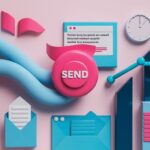Introduction:
In the bustling, often overwhelming environment of professional communication, sending and receiving emails can feel like an exhaustive task. Industry surveys indicate that the average office worker receives more than 100 emails daily, leading to stress and reduced productivity. In such a setting, mastering free email etiquette can dramatically improve your communication efficacy at work. With guidance from experts like Clare Lynch, understanding how to craft impactful emails is no longer a lofty goal but an achievable skill set. This article will delve into the nuances of email etiquette, optimizing your email correspondences, and how Clare Lynch’s insights can empower you to write more effectively.
You’ll learn:
- The importance of effective email communication at work.
- Key elements of professional email etiquette.
- Clare Lynch's perspective on writing better work emails.
- Tools and techniques to bolster your emailing skills.
- Answers to common questions about professional email writing.
The Need for Effective Email Communication
Emails have inevitably become the backbone of professional interaction in most sectors. They are quick, archivable, and, when used correctly, a powerful means of conveying information. However, their misuse can lead to misunderstandings, overflows in inboxes, and breakdowns in communication.
The cost of poor email etiquette extends beyond personal annoyance. According to surveys, over 28% of the workweek is spent in reading and answering emails, and ineffective communication cripples not only individual productivity but also overall organizational performance.
The Basics of Free Email Etiquette
Before diving into more detailed strategies, understanding the fundamentals of free email etiquette is essential. Here’s what you need to pay attention to:
1. Subject Line Precision: The subject line is the gateway to your email. A precise, informative subject helps the recipient understand the purpose at a glance. Avoid vague terms like "Urgent" or "Quick Question."
2. Professional Tone and Language: Maintaining a professional tone is crucial. Avoid slang, overly casual language, and sarcasm, which can be easily misinterpreted in written form.
3. Conciseness and Clarity: Time is a valuable commodity. Be concise but ensure that your message is clear. Break down complex ideas into bullet points and short paragraphs.
4. Proper Salutations and Closures: Begin with a respectful greeting and end with a courteous closure. This shows respect and appreciation for your reader’s time.
5. Proofreading: Typos and grammatical errors can undermine your professionalism. Proofreading before clicking send saves you embarrassment and time on clarifications later.
Insights from Clare Lynch: Writing More Effective Emails at Work
Clare Lynch, an esteemed business communication expert, provides impactful strategies for crafting effective workplace emails. Here's how her insights align with free email etiquette:
Practical Strategies from Clare Lynch:
-
Audience Awareness: Tailor your message to the understanding and expectations of your recipient. Whether it’s a colleague, a superior, or a client, aligning your message to their perspective fosters clearer communication.
-
Purpose-oriented Messaging: Each email should have a distinct goal. Lynch emphasizes the importance of clarity in outlining your expectations, which helps reduce confusion and promotes swift action.
-
Visual Formatting: Using headers, bullet points, and numbering improves readability, making it easy for recipients to grasp the main points without wading through paragraphs of text.
The Human Element in Emails:
Lynch also stresses the importance of emotional intelligence in email communications. Understanding the emotional undertones and responding appropriately enhances rapport and reduces the risk of misinterpretations.
Leveraging Tools for Better Emailing
Various digital tools can aid in implementing free email etiquette effectively:
Email Management Tools:
- Boomerang: Schedule sending and set reminders for follow-ups, ensuring timely communication.
- Grammarly: Catch typos and improve grammatical clarity, boosting your email’s professionalism.
- Clean Email: Organize and filter your emails to maintain inbox productivity.
Using these tools can alleviate common emailing challenges like clutter, missed communications, and grammatical slip-ups, enabling you to focus more on crafting effective messages.
FAQs About Effective Workplace Emails
Q1: What should I do if I don’t receive a reply to an important email?
If there’s no response, a polite follow-up can serve as a nudge. Use clear subject lines and reiterate the urgency of the matter, but always remain courteous.
Q2: How do I handle negative feedback over email?
Stay professional and detached. Address the feedback constructively, highlighting any areas you agree on and proposing solutions for areas of disagreement.
Q3: Is using emojis in professional emails acceptable?
While increasing in acceptance, it largely depends on your workplace culture and your existing relationship with the recipient. If in doubt, it’s better to err on the side of formality.
Summary
Mastering free email etiquette, as elucidated by Clare Lynch, not only improves individual communication but also enhances overall workplace efficiency. Remember to:
- Write clear, purpose-driven subject lines
- Maintain a professional tone
- Ensure clarity and conciseness
- Greet and close politely
- Proofread diligently
Equip yourself with the right tools to streamline your email tasks. Following these guidelines will transform your emails from mundane tasks into efficient, professional communications that bridge gaps in understanding and foster stronger workplace connections.
By embracing these strategies and continuously honing your skills, emailing can become a potent tool in your professional arsenal, significantly amplifying effectiveness and reducing communication errors.
In the end, committing to continuous improvement and employing expert insights will empower you to write more effective emails at work—fulfilling not just your intent but also ensuring clarity, respect, and understanding across all communication channels.



